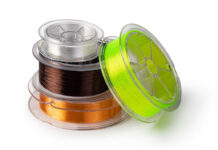Introduced in the mid-1800s, the petroleum-based polymer is in kayaks, fishing line, lures, coolers, technical clothing, tackle boxes, water bottles and even the wrapper on a sandwich.
We’re surrounded by plastic, but what do you know about this modern miracle of chemistry? Here are some fascinating facts about this ubiquitous material.
- Plastic traveled with early astronauts into space. A suitcase-size emergency return-to-earth kit contained a plastic bag filled with polyurethane foam, a small de-orbit rocket and a parachute. Good luck!
- In the 1991 film Terminator 2: Judgement Day, the evil cyborg’s body was made of a polymer and able to melt and reform. Scientists have now developed a real-life T1000 polymer, the world’s first self-fixing plastic which is called, you guessed it, the Terminator.
- The official city bird of Madison, Wisconsin is the plastic pink flamingo.
- Every year more than 6,000 Americans rush to emergency rooms after injuring themselves opening plastic packages.
- Not all plastics are petroleum based.In 1941, Henry Ford made a car from hemp and soybean plastic. Today, a number of plastic products are made from plant resins, derived from corn, sugar cane and sweet potatoes.
- In 2009, Frito-Lay introduced a bio-plastic bag for SunChips but nixed the project after consumer test groups deemed the crinkling sound too loud when trying to open the bag.
- In 1950, the cigar company Nat Sherman applied for a patent for the first plastic-tipped cigar.The patent was denied but the company successfully kept competition at bay by labeling Patent Pending on its cigar packages and threatening legal action.
- There’s an average of 46,000 pieces of plastic per square mile of ocean. Approximately 90 percent of all trash floating on the surface is plastic, much of it microscopic.
- You’ve probably got plastic chemicals in your body.93% of Americans, ages six and older, test positive for bisphenol A (BPA), which has been used in polycarbonate plastics and epoxy resins since the 1960s and is a potential carcinogen.
Follow us @kayakanglermag for all your fishing facts.






